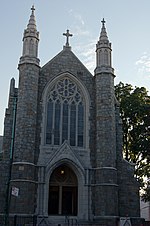New Greek TV
New Greek TV (NGTV) is an American Greek language television channel broadcasting from studios in Astoria, New York. It launched in December 1987 as 'National Greek Television' on Time Warner Cable by its founder Demetris Kastanas. NGTV was the first-ever television channel catering to Greek-Americans, airing a mix of original programming produced specifically for the local Greek-American community in New York and area as well as foreign content sourced directly from Greece. On 2 August 2012, NGTV was sold to a private investment group headed by Greek American celebrity TV host Yanna Darili. Upon taking ownership of the channel, Ms. Darilis subsequently re-branded the channel with a new look and a new focus. The new service, now called 'New Greek TV' is aimed at the new generation of Greek-Americans. In September 2014, NGTV launched in Canada on Bell Fibe TV via an agreement with Canadian ethnic broadcaster Ethnic Channels Group. It also launched in the USA on RCN Cable; it is currently only available in the New York City market.
Excerpt from the Wikipedia article New Greek TV (License: CC BY-SA 3.0, Authors).New Greek TV
Steinway Street, New York Queens County
Geographical coordinates (GPS) Address Nearby Places Show on map
Geographical coordinates (GPS)
| Latitude | Longitude |
|---|---|
| N 40.761388888889 ° | E -73.916666666667 ° |
Address
Steinway Street 30-95
11103 New York, Queens County
New York, United States
Open on Google Maps








